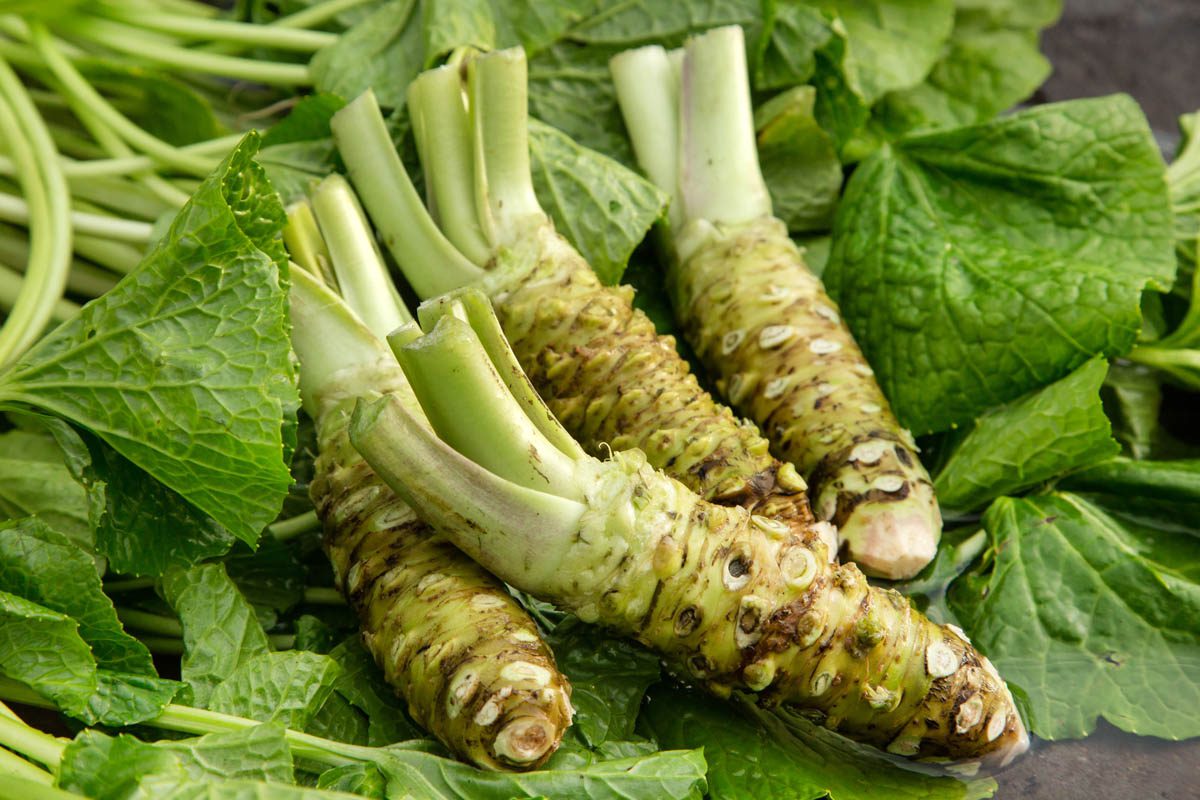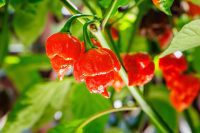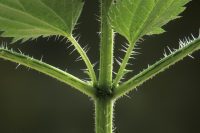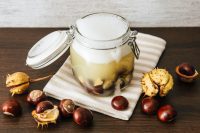Why is wasabi hot? Ι Mechanism of action Ι What is wasabi? Ι What is the purpose of allyl isothiocyanate? Ι Cultivation Ι Potential health benefits Ι What does wasabi taste like? Ι Is wasabi hotter than chilli? Ι What is wasabi made of? Ι How to prepare wasabi Ι Can you eat straight wasabi? Ι Why is wasabi so expensive? Ι What is the wasabi challenge?
Why is wasabi hot?
Wasabi is known for its unique and intense heat. The cause is an organosulfur compound called allyl isothiocyanate (AITC) which is produced by plants belonging to the Brassicaceae family. Allyl isothiocyanate is found throughout the entire plant, but the highest concentration is found in the rhizome (underground stem).
When ingested, allyl isothiocyanate triggers a reaction in the mucous membranes of the nose and mouth, leading to the sensation of heat and burning. Unlike capsaicin, the compound responsible for the sensation of burning in chillies, wasabi’s heat is not related to pain receptors. Allyl isothiocyanate stimulates the nerve receptors responsible for detecting heat. To put it in simple terms, wasabi stimulates a sense of heat in the nose while chilli stimulates a sense of pain in the tongue.
The intensity of the heat depends on several factors, such as the freshness of the wasabi, the variety, cultivation time, how it was prepared, and individual sensitivity. Some people may only experience a mild burning sensation, while others might find wasabi almost unbearable. Consuming hot chillies or wasabi can induce a sense of euphoria due to the release of endorphins in response to the pain.
Mechanism of action
- Wasabi contains sinigrin (sulfur-containing compounds called glucosinolates), which are stored in special cells in the plant called myrosin cells. When the wasabi rhizome is grated, the enzyme myrosinase is activated by a process known as enzymatic hydrolysis. Myrosinase catalyses the hydrolysis of sinigrin into breakdown products including thiocyanates, nitriles and allyl isothiocyanate (AITC), the compound that gives wasabi its distinctive flavour and heat sensation.
- Allyl isothiocyanate attaches to the transient receptor potential cation channel subfamily A member 1 (TRPA1) receptors located on the membranes of cells in the mouth, nasal passages, and eyes. This, in turn, activates the TRPA1 ion channels which cause an influx of positively charged ions, such as calcium and sodium ions, into the cells.
- The influx of positively charged ions leads to depolarisation (a change in the membrane potential of a cell), generating an electrical signal that is transmitted to the sensory nerve fibres that are located close to the TRP channels.
- The activation of nerve fibres triggers the release of substance P and calcitonin gene-related peptides, which are neuropeptides that play a role in the transmission of pain signals.
- The release of neuropeptides triggers a response from the brain, leading to the perception of heat in the nasal cavity and watery eyes. Additionally, the trigeminal nerve is connected to the tear ducts and nasal passages, which can trigger watery eyes and nasal secretions.
What is wasabi?
Wasabi is a pungent green paste made from the wasabi or Japanese horseradish plant (Eutrema japonicum orWasabia japonica) that is commonly served as a condiment for grilled eel, sushi, sashimi and soba noodles. E. japonicum is a cruciferous vegetable native to Japan in the Brassicaceae family.
Wasabi paste is known for the sensation of heat in the nasal cavity it produces when ingested. This sensation is different to that of chilli, which produces a painful sensation in the mouth. I would compare the sensation of wasabi to inhaling something hot, while ingestion of hot chillies feels like you’ve eaten something hot and your mouth is burning.
The highest concentration of AITC is typically found in the freshly grated rhizome, while the leaves and stems contain much lower amounts of the compound. Interestingly, as a grower of wasabi myself, I have found the leaves have a subtle wasabi aftertaste, without the heat and make a great addition to salads.
Wasabi is used as a condiment with raw fish dishes in Japan to prevent food poisoning. The biocidal properties of wasabi can kill harmful bacteria which include Vibrio parahaemolyticus, Campylobacter jejuni, Escherichia coli O157: H7, Staphylococcus aureus, Salmonella spp., and Helicobacter pylori.
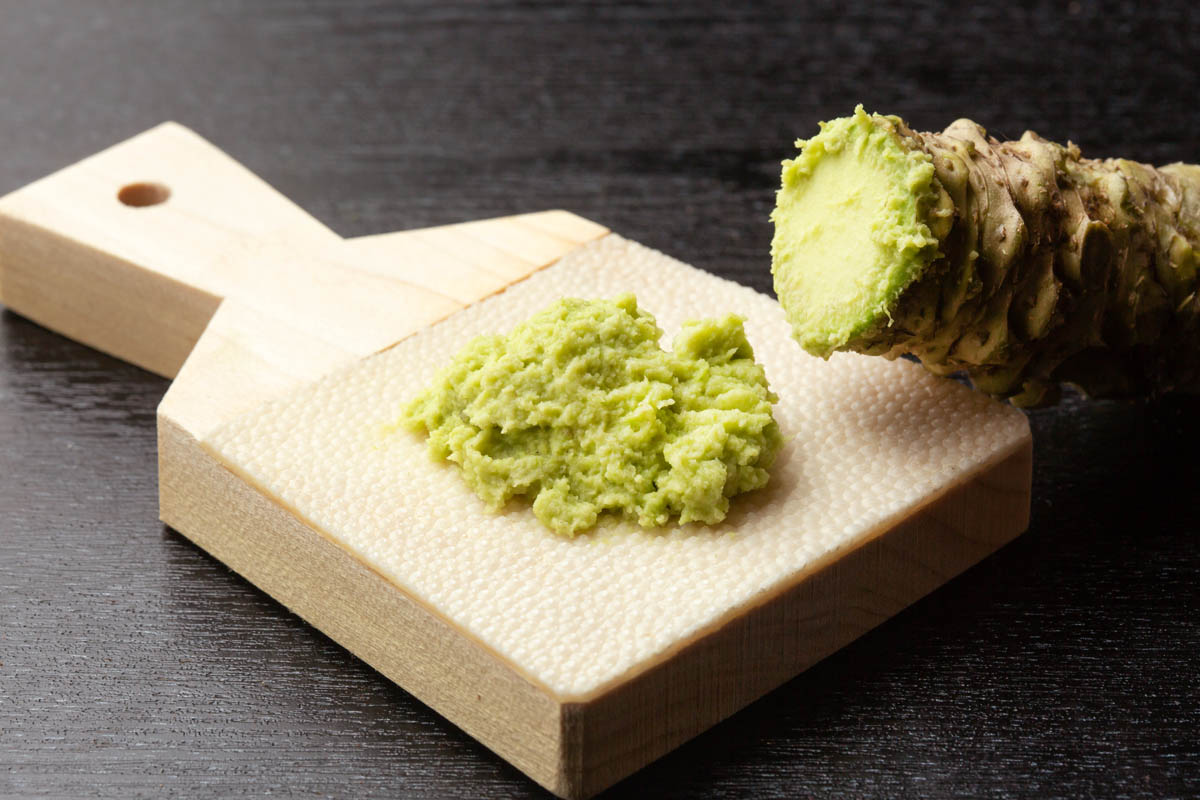
What is the purpose of allyl isothiocyanate?
Allyl isothiocyanate is a secondary metabolite (a metabolite not responsible for growth or reproduction) that is produced to protect the plant against herbivory.
When an animal or insect attempts to eat the wasabi plant, allyl isothiocyanate is released, causing a burning sensation, which acts as a deterrent against future attempts to consume the plant.
Cultivation
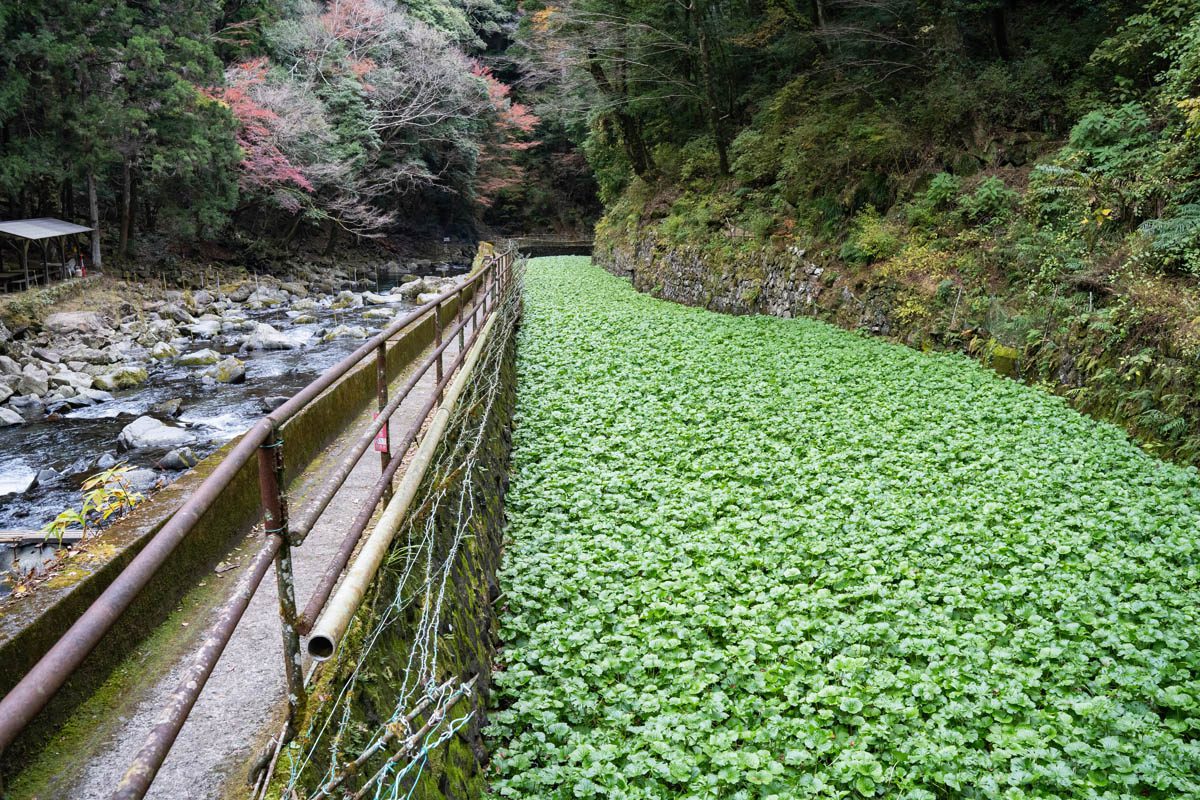
Wasabi is a semi-aquatic plant that grows alongside the shallow waters of mountain streams and wetland habitats where it receives a constant supply of fresh water, and a shady environment. In Japan, E. japonicum is cultivated primarily in Shizuoka and Nagano Prefectures.
There are two types of cultivation methods: Sawa-wasabi (water wasabi), and Hata-wasabi (land wasabi). Sawa-wasabi grows in the mountainous springs at a water temperature of 8 – 18°C. Hata-wasabi is cultivated in fields, or in forests (Hantan wasabi). Farmers protect field-grown wasabi by planting trees to provide shade. Hata-wasabi is typically cultivated for its leaves and stems and when pickled, the mildly spicy taste pairs well with rice.
Roots are also edible, but they take many years to grow large enough to eat.
The Food and Agriculture Organisation of the United Nations (FAO) designated traditional wasabi cultivation in Shizuoka prefecture as a globally important agricultural heritage system in March 2018.

Potential health benefits

TRPA1 channels are involved in the regulation of inflammation, and their action has been shown to induce the release of pro-inflammatory cytokines, chemokines and immune cells to the site of inflammation. TRPA1 channels have been implicated in a number of physiological processes such as respiratory and cardiovascular function, neuropathic pain, migraine and asthma. It is hoped that research will lead to the development of new therapies for pain and inflammation.
Some of the potential health benefits of wasabi include:
- Anti-inflammatory: Wasabi contains several anti-inflammatory compounds including catechins (epicatechin, epicatechin gallate, gallocatechin, and catechin gallate), isothiocyanates and 6-(methylsulfonyl) hexyl isothiocyanate (6-MITC), that have been shown to have anti-inflammatory properties, which may help reduce inflammation throughout the body.
- Anti-cancer: Some studies suggest that compounds in wasabi may have anti-cancer properties, particularly in the prevention of certain types of cancer such as breast and colon cancer.
- Anti-bacterial: Wasabi also contains compounds that have been shown to have anti-bacterial properties, which may help protect against certain infections.
- Digestive health: Wasabi may help promote healthy digestion by increasing the production of digestive enzymes in the pancreas.
- Cardiovascular health: Some research suggests that wasabi may help reduce the risk of heart disease by lowering blood pressure and improving blood flow.
Is wasabi hotter than chilli?
That can depend on the type of chilli ingested and the amount of wasabi. Wasabi is generally used sparingly as a condiment. Ingestion of a mild chilli produces little heat compared to say a Scotch Bonnet or Carolina Reaper, both of which have a high Scoville score.
Interestingly, the heat from wasabi is different from that of chilli peppers, which contain capsaicin. Capsaicin stimulates a different set of receptors in the mouth and throat, causing a different type of heat. Additionally, wasabi’s heat is typically short-lived, while capsaicin’s effects can last much longer. From personal experience, the hot sensation from wasabi is short-lived, lasting up to 30 seconds, ingestion of a hot chilli can last several minutes.
What does wasabi taste like?
The flavour of wasabi is described as pungent, hot and slightly peppery. It has a similar taste to that of horseradish, which shares the same active compound.
When you first taste wasabi, you will notice a sharp, intense heat in the nasal passages, which may also induce eye-watering. After the initial heat subsides, you may notice a savoury or peppery aftertaste, depending on what the wasabi is served with.
What is wasabi made of?
True wasabi is made from the ground rhizomes of the wasabi plant. However, due to the high cost, it is not uncommon to receive products that are marketed as wasabi, but in fact, contain substitutes like wasabi leaves and stems, horseradish, mustard and food colouring to mimic the taste and appearance of wasabi. These products are cheaper than real wasabi and are commonly used in restaurants and homes as a substitute. It’s important to note that the taste and flavour of knock-off wasabi can differ significantly from real wasabi, and they may not have the same antibacterial and health benefits as the real thing.
The Japanese use the term Hon-wasabi (本わさび) when referring to true or authentic wasabi. Hon (本) means ‘real‘, and the term hon-wasabi distinguishes true wasabi from other products that may be labelled as wasabi but contain other ingredients such as horseradish or mustard.
How to prepare wasabi
- Remove the outer skin of the wasabi root using a sharp knife or a vegetable peeler.
- Use a grater to grate the wasabi root into a paste. Traditionally, a sharkskin grater is used to grate wasabi, but you can also use a fine grater or a microplane.
- Add a small amount of water to the paste to prevent the grated wasabi from drying out and enhance the flavour.
- Let the wasabi paste rest for a few minutes to allow the flavour to develop.
- Use immediately or store it in an airtight container in the refrigerator for up to a day.
Can you eat straight wasabi?
It’s unlikely anybody would take a bite out of a wasabi rhizome, and if they did, they would inevitably be hit with the characteristic sensation of heat. Wasabi is typically used as a condiment in small amounts due to its potency. Genuine wasabi is generally made up of wasabi, which is grated using a traditional tool known as a ‘wasabi or sharkskin grater’ and a small amount of water is added to make it into a paste. The stems and flower buds are pickled.
The leaves of wasabi can be regularly harvested and used in salads for their subtle wasabi flavour.
Why is wasabi so expensive?
Wasabi is difficult to grow on a commercial scale with specific conditions to thrive. It requires a plentiful supply of fresh water and shade. Cultivation requires a lot of time, including hand pollination and constant monitoring of water and temperature levels. Fresh wasabi has a short shelf life and is best consumed within a few weeks of harvest. This means fresh wasabi must be shipped quickly and cannot be stored for long periods. And finally, wasabi is a popular condiment in Japanese cuisine and has become increasingly popular around the world. This high demand, combined with the factors mentioned above can drive up the price of wasabi.
It is possible to grow wasabi at home but takes between 18 – 24 months before the rhizome is ready to harvest. During this time, the leaves can be removed and used in salads.
Despite its reputation for being difficult to grow, I have had success with two pots of wasabi in my garden in Australia. It grows in an east-facing position, however, the area receives no direct sunlight due to an overhanging tree and large bamboo plants that provide adequate shade. The plants were purchased in September 2022 and as of now, April 2023, are continuing to thrive, and have already outgrown their pots once.
We have received significant rainfall this spring and summer, and no days over 40°C, which no doubt has contributed to the success of these plants. However, I have also been actively monitoring the pots to ensure the soil remains moist, but not waterlogged at all times. As the photo of my plant below shows, the main issue is keeping the snails away.

Conclusion
- Wasabi contains compounds called glucosinolates, which are stored in special cells in the plant called myrosin cells. When the cells are damaged by grating or crushing, an enzyme called myrosinase is released from the cells and comes into contact with glucosinolates, leading to the breakdown of these compounds into smaller molecules.
- The primary breakdown product of glucosinolates in wasabi is allyl isothiocyanate (AITC), which is responsible for the pungent flavour and aroma of wasabi. AITC is a volatile compound that stimulates the trigeminal nerve in the mouth, causing a sensation of heat and pain.
- AITC is different to capsaicin, the compound that gives chilli its heat.
- The pungency of wasabi can vary depending on factors such as the age of the plant, growing conditions, and the processing method used. Wasabi that is freshly grated or crushed tends to be hotter than that which has been processed into a paste or powder.
- Wasabi is a popular condiment in Japanese cuisine and is often served with raw fish as a preventative to food poisoning.
What is the wasabi challenge?
Brooklin Beckham, son of David and Victoria Beckham made news recently by joining the viral ‘wasabi challenge’. The goal of this challenge is to eat a cherry-tomato-sized ball of wasabi (or in some cases more) and record your response. While ingesting large volumes of wasabi is going to cause an intense feeling of discomfort, it is probably one of the less harmful challenges out there. Bear in mind though, most supermarket-bought wasabi isn’t true wasabi but contains horseradish or mustard instead. Not that it really matters that much.
Julia is a writer and landscape consultant from Wollongong with a love of horticulture. She had been an avid gardener for over 30 years, collects rare variegated plants and is a home orchardist. Julia is passionate about learning and sharing her knowledge of plant propagation and plant toxicology. Whether it’s giving advice on landscape projects or sharing tips on growing, Julia enjoys helping people make their gardens flourish.
